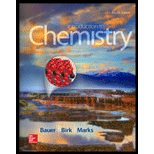
Interpretation:
The difference between
Concept Introduction:
The steps involved to name a molecular compound are as follows:
First, identify that the given compound involves the combination of two non-metals or a non-metal and a metalloid.
Identify the
Start the name with the name of the first element in the compound.
If more than one atom is present, use prefixes as di, tri, and tetra.
Then, state the root name of the second element with a proper suffix.
The naming representation for acid starts with ‘hydro’ as the prefix followed by the name of the metal or the non-metal with the use of ‘ic’ as a suffix.
Want to see the full answer?
Check out a sample textbook solution
Chapter 3 Solutions
Introduction to Chemistry
- The compound potassium iodide, KI is soluble in water. Write the formulas for the ions that interact with water as shown in the models when solid potassium iodide dissolves in water:arrow_forwardPart A There are conventions for naming and constructing the formulas for acids and bases just as there are for other types of compounds. There are three main rules for naming acids, as shown in the table. For example, an acid that contains a hydrogen ion and an acetate anion is called acetic acid What is the chemical formula for the base iron(III) hydroxide? Type of acid Naming convention Express your answer as a chemical formula. Hydrogen ion Nonmetal anion Prefix hydro Change nonmetal ending to ic acid • View Available Hint(s) Hydrogen ion Polyatomic ion ending in ate No prefix Change polyatomic ion ending to ic acid ΑΣφ Hydrogen ion Polyatomic ion ending in ite No prefix Change polyatomic ion ending to ous acid There is one main rule shown in the table for naming bases. For example, a base that contains a sodium ion and a hydroxide ion is called sodium hydroxide. DA chemical reaction does not occur for this question. Type of base Naming convention Submit Metal ion Metal name…arrow_forwardWhat’s the difference between hydrochloric acid and chloric acid?arrow_forward
- - What is the chemical formula for the compound formed between cobalt(III) and the chlorate ion? - What is the chemical formula for the compound formed between cobalt(III) and the phosphate ion?arrow_forwardWhat is the formula for hydroxide ion? what is the formula for hydrogen sulfate ion?arrow_forwardQUESTION 1 questions. Just give the answer only. Make sure that your answers are carefully numbered. Give short answers to each of the following questions. Do not copy the (a) A homogeneous mixture which contains water as a solvent is called (b) Ni(CIO4)2-6H2O is hydrated whereas Ni(CIO4)2 is (c) Nacl contains an bond whereas O2(g) contains a bond (d) A homogeneous mixture has a and composition (e) Temperature is an, because it does not depend on the amount of substance (f) The maximum number of electrons that an orbital can have is (g) The energy of the lowest level in the H atom is (h) Arrange the following subshells in the H atom in order of increasing energy: 3s 4d 2p 41 3d 2s 3p (i) Wavelength and frequency of, radiation have an relationship (i) In an atom, what is the maximum number of electrons that can have the following set of quantum numbers? n = 4, m =-1, m, = +% (k) Draw a 3d2 orbital and describe it in your own words. (1) Write the ground state electron configuration for…arrow_forward
- How do I differentiate an acid from a base by simply looking at the name of each given compound?arrow_forwardQUESTION 1 questions. Just give the answer only. Make sure that your answers are carefully numbered. Give short answers to each of the following questions. Do not copy the (a) A homogeneous mixture which contains water as a solvent is called (b) Ni(CIO4)2·6H2O is hydrated whereas Ni(CIO4)2 is (c) NaCl contains an bond whereas O2(g) contains a bond (d) A homogeneous mixture has a and composition (e) Temperature is an because it does not depend on the amount of substance (f) The maximum number of electrons that an orbital can have is (g) The energy of the lowest level in the H atom is (h) Arrange the following subshells in the H atom in order of increasing energy: 3s 4d 2р 4f 3d 2s 3p (i) Wavelength and frequency of radiation have an relationship (i) In an atom, what is the maximum number of electrons that can have the following set of quantum numbers? n = 4 , m = -1 , ms = +½ (k) Draw a 3dx2- orbital and describe it in your own words. (1) Write the ground state electron configuration…arrow_forwardMolecular compounds: Are there any prefixes needed.Ionic compounds: Which ones need Roman numerals and Why?Indicate which ones have polyatomic ion and if they are they cations or anions?Are there any acids or bases? Are the acids binary acids or oxyacid? Which have a strong acid or a strong base.Why do you think it is important to understand how to write formulas? How will this knowledge help you in your healthcare career? Name Ionic Molecular Prefix Required Polyatomic Cation Polyatomic Anion Acid/ Base Strong Acid/Base Binary/ oxyacid Roman Num Name CuSO4 HCl NaOH SnCl2 HNO3 H2SO4 PCl3arrow_forward
- The compound calcium nitrate, Ca(NO3), is soluble in water. Write the formulas for the ions that interact with water as shown in the models when solid calcium nitrate dissolves in water:arrow_forwardWrite the names and formulas for the four oxy-acids containing (a) bromine, (b) iodine.arrow_forwardwhy is the arrangement of the constituent atoms or molecules more important in determining the properties of a splid than a liquid or gas?arrow_forward
 Chemistry: The Molecular ScienceChemistryISBN:9781285199047Author:John W. Moore, Conrad L. StanitskiPublisher:Cengage Learning
Chemistry: The Molecular ScienceChemistryISBN:9781285199047Author:John W. Moore, Conrad L. StanitskiPublisher:Cengage Learning World of Chemistry, 3rd editionChemistryISBN:9781133109655Author:Steven S. Zumdahl, Susan L. Zumdahl, Donald J. DeCostePublisher:Brooks / Cole / Cengage Learning
World of Chemistry, 3rd editionChemistryISBN:9781133109655Author:Steven S. Zumdahl, Susan L. Zumdahl, Donald J. DeCostePublisher:Brooks / Cole / Cengage Learning


